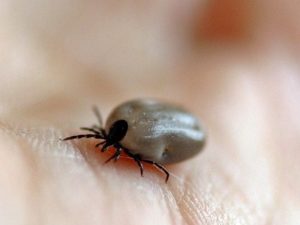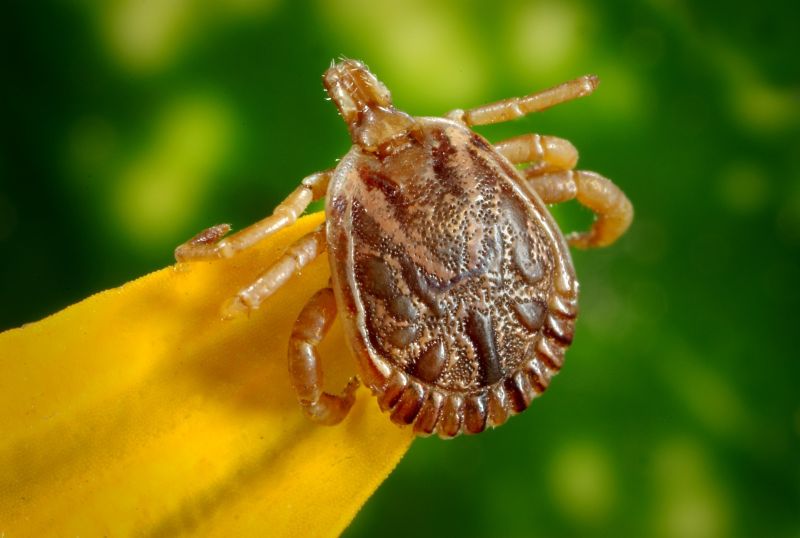This post may contain affiliate links. If you click on a link and make a purchase I earn a small commission at no extra cost for you.
Why Repelling Ticks Is So Important!!!
Ticks are all around us. Everywhere out in nature where hikers, campers, and nature lovers move, there is the risk of getting bitten by ticks. They are found on kid’s playgrounds as well as on your favorite family campsite.
They lurk in high grass, shrubbery, and undergrowth waiting for a host, they latch on, bite, and drink blood. But it is not only for the bite and the discomfort it creates. Ticks can transmit dangerous diseases through their bite. It is important to know about tick behavior and what repels ticks to prevent getting bitten.
The best protection against ticks and tick-borne diseases is a really good Tick Repellent, protective clothing, and treating your gear and tent. You should also learn about ticks and where they live and the diseases they can transmit. The more you can protect yourself and your family.
There are plenty of tick repellents and remedies available but which help best. You can choose between a chemical and natural tick repellent. A tick repellent may be applied to your body, but there are also products that are applied to clothing to keep ticks off.
Synthetic insect repellent with DEET or Picaridin
Synthetically manufactured insect repellants are usually highly effective. The active ingredients DEET and Picaridin provide protection against ticks, mosquitos, and many other little crawlies. In rare cases, side effects can occur. Read instructions and use as directed
No products found.
Natural herbal bug repellents
If you don’t want to use synthetic repellents, you can also use insect repellents that contain natural active ingredients extracted from plants. Usually a mixture of different essential oils. But be careful, even if it is natural plant-based it must only be used as instructed.
No products found.
Surface sprays to treat to gear
For camping in tick-infested areas, it is also advisable to treat tents or clothing and shoes with tick-repellent. There are a variety of sprays that contain permethrin that is very easy to apply and provide protection for many weeks.
No products found.
What are Ticks?
 Ticks are spiders (arachnids), you see this on the 8 legs they have. All insects have only 6 legs. Ticks are parasites that need to feed on the blood of mammals, birds, and sometimes reptiles and amphibians. All of the over 800 tick species occurring worldwide can carry pathogens that can transmit diseases to their hosts. There are two families of ticks, the Ixodidae or hard ticks, and the Argasidae or soft ticks.
Ticks are spiders (arachnids), you see this on the 8 legs they have. All insects have only 6 legs. Ticks are parasites that need to feed on the blood of mammals, birds, and sometimes reptiles and amphibians. All of the over 800 tick species occurring worldwide can carry pathogens that can transmit diseases to their hosts. There are two families of ticks, the Ixodidae or hard ticks, and the Argasidae or soft ticks.
Ticks live cycle
The adult tick will again sit and wait for a host. At all, a tick spends most of its life waiting on the ground, in the undergrowth, on shrubs or grasses. The female adult tick needs the blood of the host to produce up to 3,000 eggs. During a blood meal, the ticks weight can increase up to 200 times until the tick is full. To take up so much blood may take the female tick up to 10 days before voluntarily leaving her victim. The male tick can fertilize the eggs of the female without any further blood meal.
Tick Bite – risks when bitten by a tick
The Bite: When a host is found, a tick may walk around for a couple of hours until it finds a bite site. It then cuts through the skin with its jaw claws and anchors its “harpoon-like spike” (the hypostome) into the wound. The small wound cuts capillaries from which blood flows, a tick is a so-called pool feeder.  Before taking blood in, the tick releases a saliva secret, which contains several important components:
Before taking blood in, the tick releases a saliva secret, which contains several important components:
- A coagulation inhibitor, to prevent blood clotting and increases blood flow
- A kind of adhesive that firmly anchors the mouth tools in the skin
- An anesthetic that numbs the puncture site
- An anti-inflammatory agent which is intended to avoid stimulation of the body’s immune defense at the injection site.
Infection: While feeding blood from its host, the tick regurgitates indigestible food residues into its host at regular intervals. In this process, pathogens that may have been contracted from a previous host and have been preserved or even multiplied in the tick body can be transferred. Infection does not happen immediately, but the longer an infected tick is feeding, the higher the risk of contracting a tick-transmitted disease becomes. To transfer Lyme disease, for example, takes 6 to 12 hours. Therefore, fast and careful removal of a tick is urgently recommended.
The development stage of ticks also has an influence on the risk of infection. When the tick is in the nymph stage it can contain ten times as many pathogens as an adult tick.
How to remove a tick
To remove a tick use fine tweezers that are bent at the end in an L-shape, special tick pliers, or a tick hook. For nymphs, it’s best to use a tick sling or a tick card.
To keep the infection risk for tick-borne disease as low as possible act quickly and remove the tick immediately after detection. Don’t wait until you can visit a doctor, the longer the tick remains in the bite site, the higher the risk.
Use a special tick removal tool. Grasp the tick at the front of the head right near the skin with the tweezers and pull it out. Do not squeeze the tick’s body, when it is squashed pathogens from the tick’s insides may be forced into the bite wound.
Don’t kill the tick as long as it is still latched on using heat, oil, repellent, or glue, as the tick may vomit into the wound. After removal, disinfect the bite site with alcohol and clean it. If the tick’s head comes off, don’t worry, the bad stuff is in the tick cuts. A doctor can remove the head if it has not fallen off by then.
No products found.
Tick-transmitted diseases
Tick-borne diseases are caused by various types of bacteria, viruses, and protozoa. A tick bite may cause more than one disease as ticks can carry several different bacteria in their intestine. There are many known illnesses that ticks may transmit to humans, the most common are below. Applying tick repellent can only reduce the risk of a tick bite, there is no 100% protection against tick-transmitted diseases.
Lyme disease:
Lyme borreliosis is one of the common diseases transmitted by ticks. It is caused by bacteria that lingers in the intestine of the tick. As it takes time for the bacteria to transit from the tick’s gut to the host, the infection will take a couple of hours of feeding. There is no vaccine against borreliosis, preventing tick bite and immediate removal of the parasite is all you can do.
If infected a few days, several weeks to a few months may pass from the tick bite to the first symptoms. Since the signs are not clear but are typical of numerous diseases, a clear diagnosis is often difficult.
Lyme disease symptoms may include:
fever, limb pain, joint pain and inflammation, general exhaustion, a rash, headache, paralysis (especially in the face), circulatory and heart problems, strong pain, dry, aching and thinning skin, etc…
The bacterial infection can be completely healed if antibiotics are used at an early stage. If the borreliosis has developed into a chronic form, therapy is much more difficult and may not be complete.
Human Anaplasmosis:
Another dangerous bacterial disease and also commonly transmitted by ticks is Anaplasmosis. It is transmitted by the black-legged or deer tick. The bacteria infect white blood cells and alter their life cycle.
Common symptoms may include:
lack of appetite, body pain, difficulty moving, lethargy, nausea, sensitivity to light, etc…
There is no vaccination against human anaplasmosis. Antibiotics are the only form of treatment.
Babesiosis:
This is a parasitic malaria-like disease caused by Babesia, a microscopic parasite that infects red blood cells. The disease is rare and often asymptomatic with only mild flu-like symptoms. Only in very rare instances can it be severe and sometimes fatal. It is transmitted by the deer tick. The disease is also called Texas Cattle Fever, as cattle are a major host for the parasite.
These symptoms will include tiredness, lack of appetite, muscle ache, chills, and fever. Most patients spontaneously recover. Symptomatic patients will be treated with malaria medication like clindamycin and quinine.
Rocky Mountain Spotted Fever:
This illness is dangerous and usually transmitted through the Lone Star and the American dog tick. It is caused by Rickettsia parasitic bacteria. When infected, you will feel very sick, immediate treatment is required.
Symptoms include a sudden high fever, severe headache, nausea, vomiting, muscle pain, and skin rash. Diarrhea and abdominal pain may occur. In the early stages, the disease is difficult to diagnose since the skin rash becomes visible only about six days after the first symptoms.
Treatment with effective antibiotics must be started immediately.
Ehrlichiosis:
Symptoms of this disease will start one to 21 days after being bitten by an infected lone star or brown dog tick. It’s caused by parasitic bacteria that will infect and kill white blood cells. Symptoms may include fatigue, headache, muscle aches, fever, vomiting, nausea and in rare cases a skin rash.
Antibiotic treatment with doxycycline and minocycline is often prescribed. There is no vaccine against ehrlichiosis. Preventing tick bit with appropriate measures is all you can do.
Whether you go hiking in the woods or you spend time with the family camping, the importance of tick protective clothing and the use of tick repellent is important for anyone who is active outdoors.


